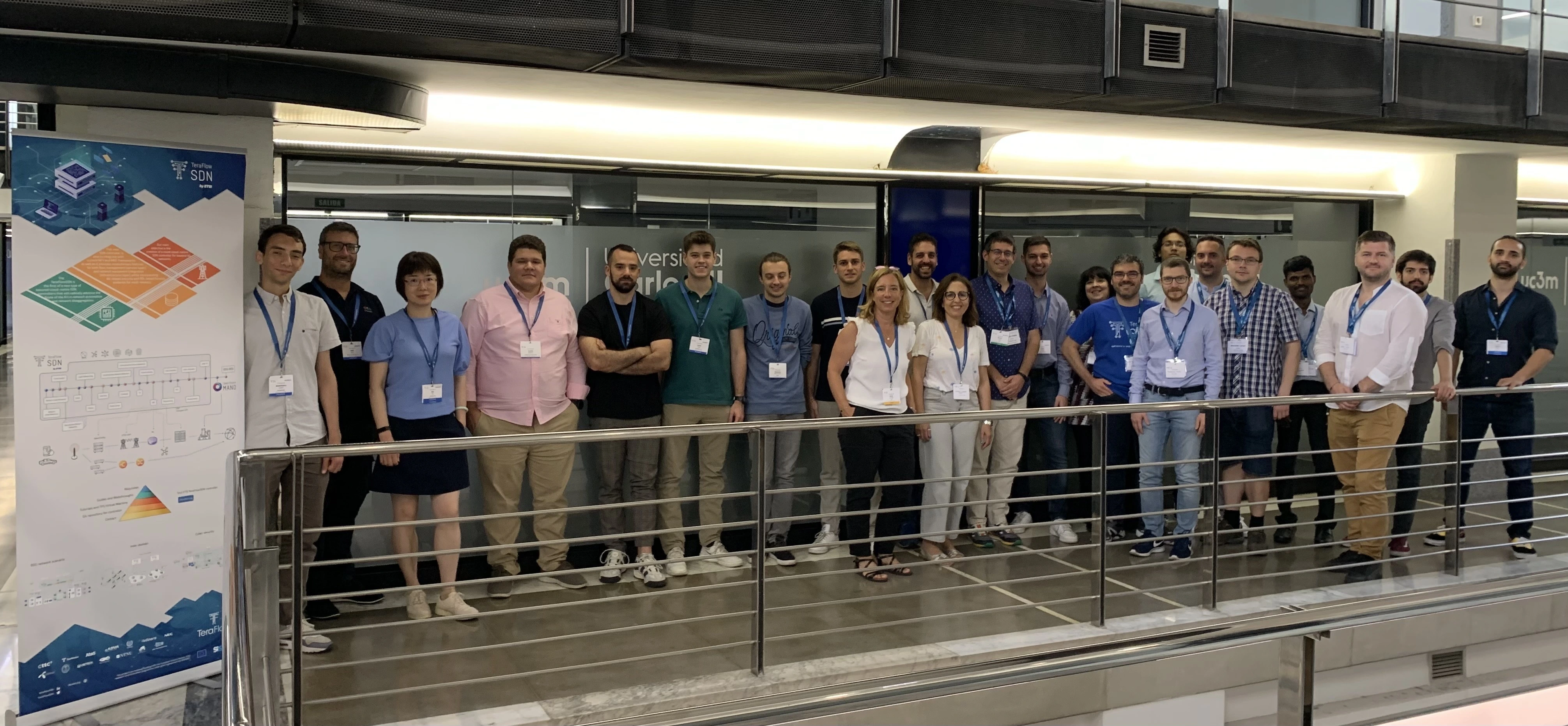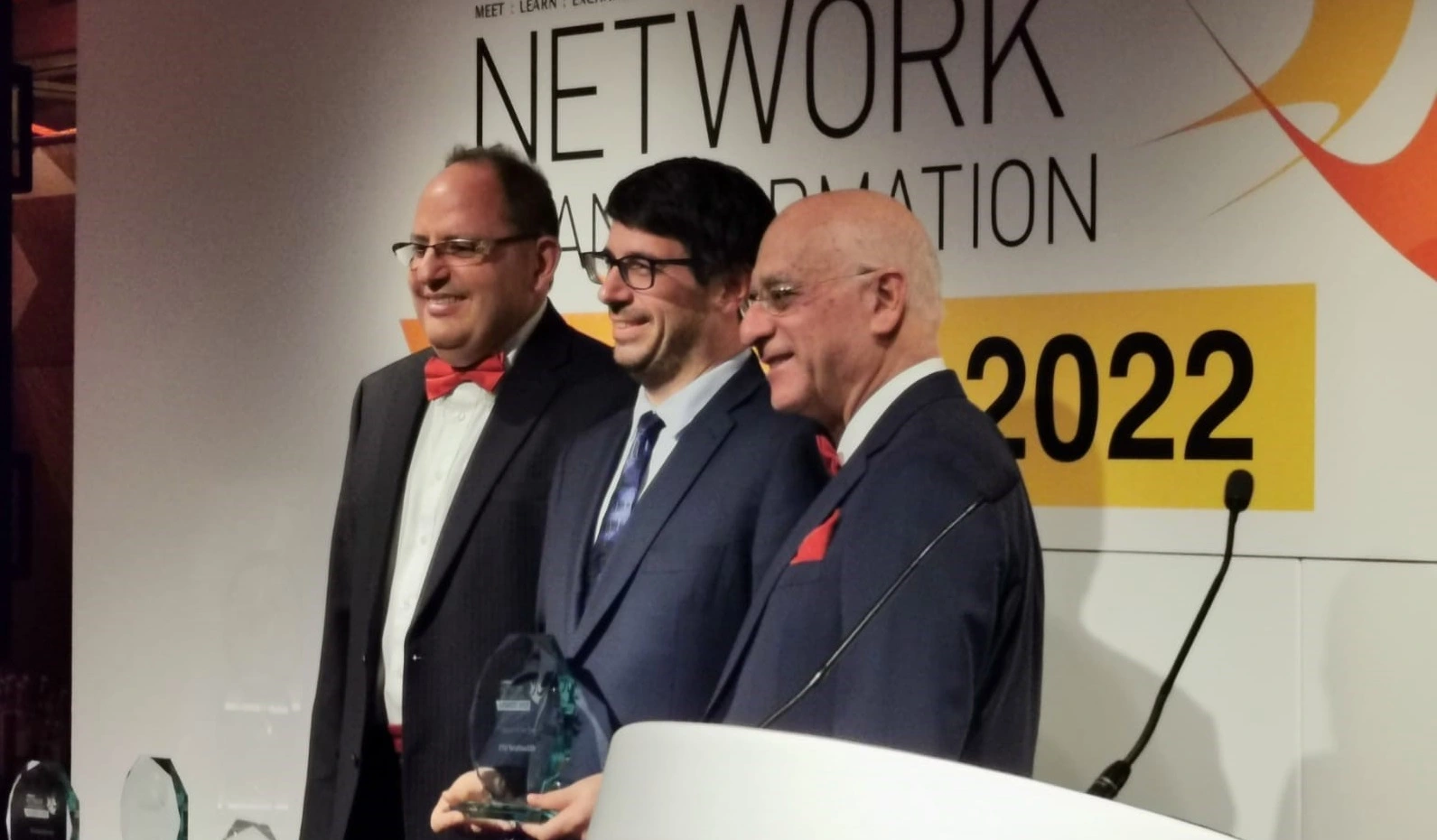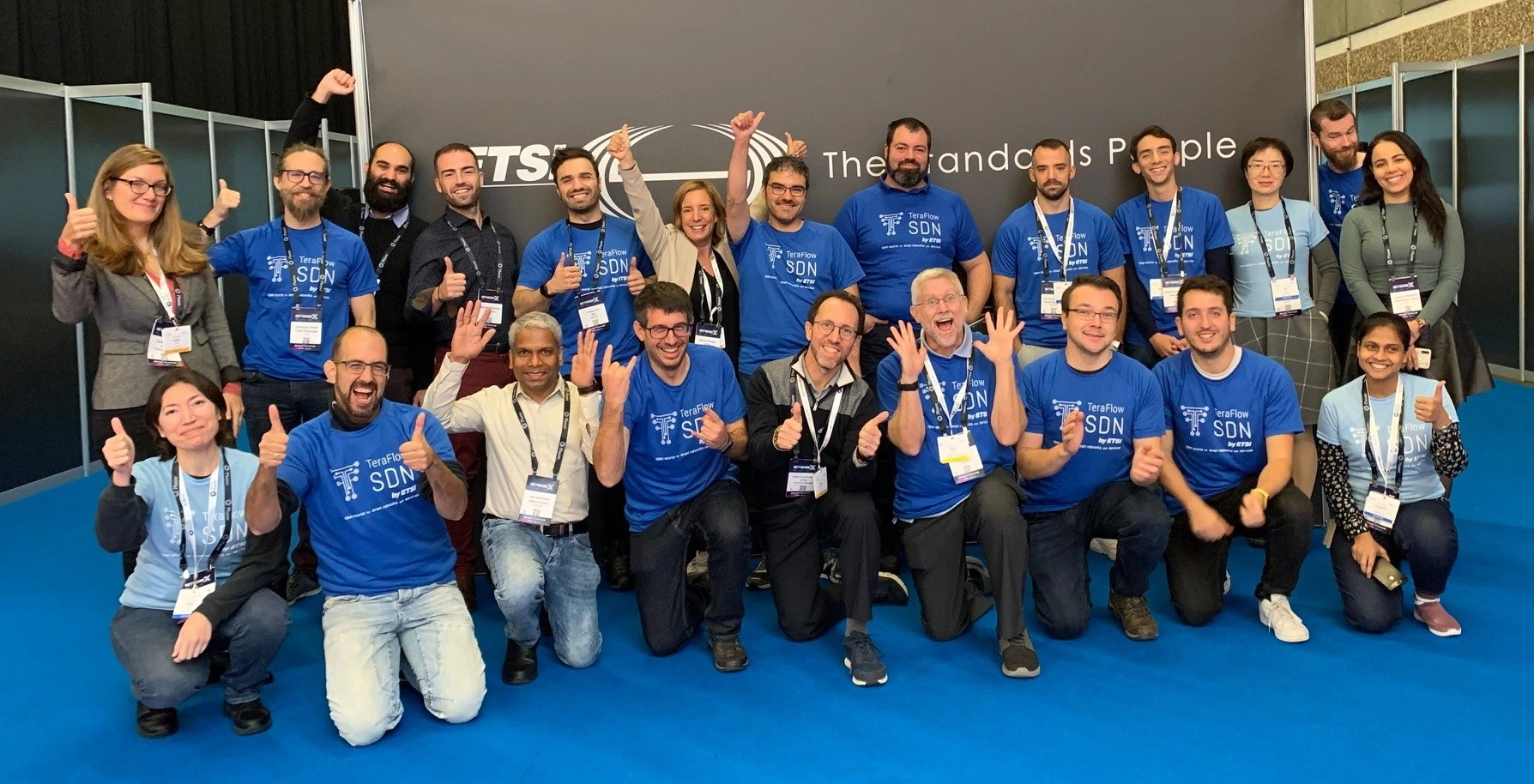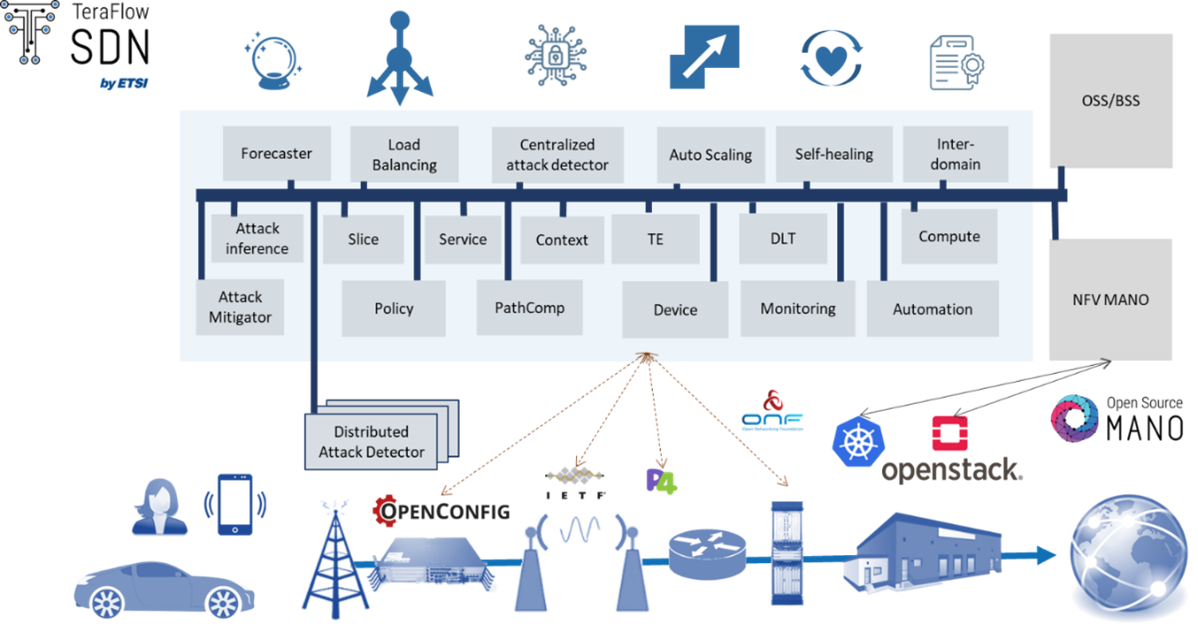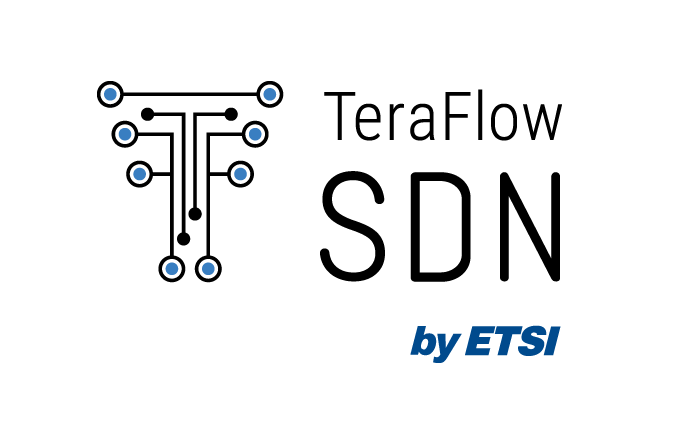October 10, 2024
Don’t miss the chance to connect with the TeraFlowSDN community at the upcoming ETSI SNS4SNS Event, 12-14 November 2024 in Sophia Antipolis (France). ETSI SDG TeraFlowSDN work will be actively featured during the conference in talks, panels, demos, posters, and of course during our fifth TeraFlowSDN Hackfest!
The event is free of charge and open to all, but seats are limited: register now!
SDG TeraFlowSDN at the SNS4SNS Conference
The Conference on Software and Standards for Smart Networks and Services will bring together experts and decision makers from different standards organizations, open source communities and research initiatives to discuss synergies, best practices and opportunities for collaboration in the design and development of sustainable and interoperable networks and services. The conference will include sessions on Access Networks and Services, Telco Cloud Infrastructure, Management, Orchestration and Operations, Network Exposure, APIs and Programmability and will conclude with a large operator panel to discuss conclusions and next steps.
Session 2 - Telco Cloud Infrastructure will be chaired by Ricard Vilalta, Chair of SDG TeraFlowSDN, and will include talks from prpl Foundation, Eficode, Telia and Telenor, followed by a panel with the speakers.
Learn more about the ETSI SNS4SNS Conference
5th SDG TeraFlowSDN Hackfest (Tutorial)
This 5th TeraFlowSDN Hackfest at the SNS4SNS event, will be a beginner-friendly comprehensive hands-on tutorial dedicated to exploring the fundamental concepts, protocols, and standards needed to deploy, onboard, control, and monitor network devices like programmable routers and white boxes.
This Hackfest provides participants with the opportunity to master the basics of TeraFlowSDN, enhancing their Smart Networks and Services projects through an industry-oriented, cutting-edge network automation framework.
In addition, attendees will learn how to engage with the community to contribute code, new features and bug reports.
Learn more about the 5th TeraFlowSDN Hackfest @SNS4SNS
TeraFlowSDN Demos
Stand 1 - Open Source for Telco-Cloud: An ETSI SDG-based solution to facilitate zero-touch, multi-slice 5G deployments across the cloud-edge continuum by Kostis Trantzas, University of Patras.
This demonstration illustrates a zero-touch delivery of a distributed 5G network across a cloud-edge continuum over multiple cloud providers, by integrating three open-source solutions of ETSI Software Development Groups (SDGs) - OSM, TFS, and OSL. To that extent, the demonstration involves the logical interconnection of public and private resources providing an adjustable and seamless network fabric over numerous network devices. Over this zero-touch created network substrate, the adopted open-source solution orchestrates the deployment of disaggregated cloud-native 5G resources, composing a multi-slice setup while also addressing access control on domain resources.
In addition, the solution employs stratum-based, programmable P4 switches to not only carry out the routing but also perform in-band network monitoring for deep visibility into the network state. In principle, the demonstrated solution relies on widely utilized, standard interfaces and data models such as TMF APIs, IETF L2/L3 VPN Service Delivery, and ETSI NFV SOL005 to achieve those objectives.
Stand 7a - Implementation of Ordered Proof of Transit (OPoT) for traffic flow path verification in the TeraflowSDN ecosystem by Javier Velázquez Martínez, Telefonica
Network connectivity in complex topologies add the risk of losing visibility and traceability of the traffic flows. Aspects such as regulatory or security policies can demand some mechanism to demonstrate this traceability of the traffic. In this demo, we showcase a novel P4 implementation deployed in the TeraFlowSDN ecosystem. This P4 implementation, called Ordered Proof of Transit (OPoT), provides a solution for validating flow paths in the network.
By using Shamir’s Secret Sharing Scheme, the system adds metadata to each packet in the network, updating it at each node or service the packet traverses until it reaches the final destination. This method ensures validation of the services traversed by the packet at the last crossing point, providing an additional layer of security and preventing unauthorized modifications to the flow of data traffic. Several mathematical parameters are required for each packet to execute OPoT. The TeraFlowSDN controller is responsible for generating these parameters and configuring each node via its P4 framework.
The demo consists of a 10-node linear topology network, virtualized with Mininet and connected to a TeraFlowSDN controller. Once both the topology and controller are deployed, TeraFlowSDN generates the mathematical parameters and configures the nodes by setting up a P4 service involving the OPoT configuration. Connectivity is then tested between two Mininet hosts at opposite ends of the network to verify the proper functionality of the system. Finally, packets are captured at various points in the network to demonstrate how nodes add and modify OPoT metadata.
Stand 7b - Multilayer Slicing Control in IP over Optical Networks Using TeraFlowSDN by Pablo Armingol Robles, Telefonica
The demo will showcase a visualization and spectrum management tool for IP-over-DWDM networks, using TAPI to adapt the optical network to IP traffic changes. It updates real-time data and optimizes spectrum allocation to enhance network performance and capacity.
Stand 8a - Integrating Quantum Key Distribution (QKD) with TeraFlowSDN by Alberto González Barneo, Optare Solutions
In this demo, we showcase the integration of Quantum Key Distribution (QKD) technology into the TeraFlowSDN controller. TeraFlowSDN is an innovative, cloud-native Software-Defined Networking (SDN) controller that enables scalable, secure, and flexible network management. The integration of QKD, which provides quantum-based encryption for secure communication, ensures the highest level of security for modern network infrastructures. Through the TeraFlowSDN WebUI, we demonstrate how to configure and manage QKD nodes, services, and applications.
The demo covers key components of the WebUI, including:
- Devices: Configuration and monitoring of QKD nodes with detailed information such as endpoints, ports, and interfaces.
- Links: Visualization and management of physical and virtual QKD links between nodes, showcasing how secure data paths are established.
- Services: Creation and management of physical and virtual services between QKD nodes, ensuring secure communication channels.
- Applications: Monitoring and control of internal and external QKD applications for secure key exchanges.
This demo highlights the synergy between Software-Defined Networking (SDN) and quantum security technologies, contributing to the goals of SNS (Smart Networks and Services) projects, particularly in securing next-generation communication networks.
By leveraging quantum encryption, this project aligns with Sustainable Development Goals (SDGs) such as SDG 9 (Industry, Innovation, and Infrastructure) and SDG 16 (Peace, Justice, and Strong Institutions) by promoting secure and resilient network infrastructures. This integration positions TeraFlowSDN as a critical tool in the future of secure communication networks, enhancing both network management capabilities and security through quantum technology.
Stand 8b - Autonomous Link-Capacity Adjustment using TeraFlowSDN Controller in a Disaggregated Optical Network Testbed by Behnam Shariati, Fraunhofer HHI
This demo showcases a closed-loop operation for the use-case of autonomous optical link-capacity adjustment in a partially-disaggregated testbed. Our proposal employs a state-of-the-art traffic forecaster for capacity provisioning and an instance of TeraFlowSDN Controller for (re)configuration of IP/Optical network elements, without interrupting the end-to-end service.
Stand 9 - Network Resource Allocation for Gaming Using MEC API and TeraFlowSDN by Shayan Hajipour, CTTC
Leveraging TeraFlowSDN (TFS), we provide a multi-access edge computing (MEC) bandwidth management service that enables dynamic bandwidth allocation and prioritizes gaming traffic for low-latency gaming. This demonstration is in collaboration with Telefónica and xFlow Research.
Stand 10 - Enabling Cloud AR/VR Gaming Services by an Open-Source and Standards-Based Network-as-a-Service Platform for Control and Management of Optical Networks by Hesam Rahimi, Huawei
This demo presents a comprehensive Standards-Based and Open-Source Network-as-a-Service (NaaS) platform designed to enhance the deployment and management of all-optical access and transport networks. This platform introduces cutting-edge ETSI F5G-A (Fifth Generation Fixed Network Advanced) access and transport network capabilities to enterprises, users, and application developers.
Our implementation is standards-based leveraging GSMA’s Open Gateway initiative, Linux Foundation’s CAMARA, ETSI ZSM and ETSI F5G ISGs. We collaborate with ETSI ZSM and F5G ISGs, not only to improve our design by exploiting the solutions from these standards, but also to help validate the ZSM and F5G standards by conducting and examining the proof-of-concept (PoC) demonstrations of our NaaS platform.
We have also integrated a number of open-source projects into our platform including ETSI OSM and ETSI TeraFlowSDN. We demonstrate our platform with a use-case of cloud-based AR/VR gaming service that requires high bandwidth and ultra-low latency. This is achieved through an end-to-end, quality-on-demand connectivity service that incorporates both access and transport network slicing.
For the transport network slicing, our platform uses ETSI F5G’s fine-grain Optical Transport Network (fgOTN) technology realized by an end-to-end, Layer 3 VPN (L3VPN) service. For the access network, our solution introduces the novel aspect of automated Passive Optical Network (PON) slicing, achieving a fully end-to-end solution. We also use standard data models from IETF to define our network slices and L3VPN services.
This PoC not only highlights a technological milestone but also sets the stage for the future of end-to-end quality-enabled telecommunications. By leveraging the latest ETSI standards and technologies, this collaboration exemplifies how the F5G-A architecture can support not just immersive and realistic VR gaming services but also a wide array of other highly-demanding digital services and applications.
Learn more about TeraFlowSDN Demos @SNS4SNS
Posters
Closed Loop Automation Platform for Intelligent Security Operations with TeraFlowSDN and OSM. by Allen Abishek, CTTC
The poster demonstrates a Closed Loop Automation (CLA) platform that enhances network security through automated responses. It integrates components like Traffic Sniffer, AI-Inference, Attack-Detector, and Attack-Mitigator to detect and mitigate threats in real-time. The platform improves security resilience and automates operations, reducing detection and recovery times for malicious attacks in the network environment.
F5G & ZSM PoC: F5G-advanced access and transport network with autonomous service management enabling End-to-end CAMARA QoD Services for Cloud AR/VR Gaming by Lluis Gifre, CTTC
This poster aims to illustrate the demonstration of a network-as-a-service platform deploying CAMARA QoD services for Cloud AR/VR gaming, relying on an F5G-Advanced network that provides end-to-end network slices with flow service classification, differentiation, monitoring/telemetry, and assurance based on closed-loop automation. It leverages ETSI SDG TFS and OSM.
ZSM-Based Automation for Dynamic Configuration and Monitoring of Packet and Optical Network Layers by Mikos Psaromanolakis, Ubitech
The sixth generation (6G) of mobile networks promises faster speeds, greater bandwidth, lower latency, and enhanced reliability, all within continuously evolving environments. To meet these demands, it is crucial to provide solutions to automate end-to-end (E2E) 6G network orchestration, ensuring dynamic network adaptations based on operators’ requirements, as described by Service Level Agreements (SLAs).
This poster introduces a novel approach being developed within FLEX-SCALE project, enabling automatic and dynamic (re)-configuration across both optical and packet domains, by leveraging and extending ETSI TeraFlow SDN with a new control and monitoring system architecture. The key component of this system is the automation, which offers closed loop functionality based on the Zero touch network & Service Management (ZSM) architecture and stages provided by ETSI GS ZSM 009. It operates on top of the other control and monitoring components for ensuring real-time surveillance and (re)-configuration of network entities without any human intervention.
In parallel, the newly introduced KPI, telemetry, and analytics system provides flexibility and seamless integration, in a concerted way, of various metrics and advanced analytics algorithms, covering any complex demand that may arise in both packet and optical domains. Lastly, all implementations related to the introduced extensions and new components are open-sourced and already available via the ETSI TeraFlow SDN GitLab, fostering innovation, transparency, and collaboration.
Multi-domain Security and Trust Orchestration Leveraging TeraFlowSDN and Open Source MANO bu Shayan Hajipour, CTTC
This poster introduces a platform for orchestrating security and trust across multi-domain network slices with various security providers. It combines technologies like ZSM and Blockchain, using TeraFlowSDN and Open Source MANO to enable the platform to instantiate network connections and services.
Learn more about TeraFlowSDN Posters @SNS4SNS
About ETSI SDG TeraFlowSDN
SDG TeraFlowSDN develops an open source cloud native SDN controller enabling smart connectivity services for future networks beyond 5G.
These advancements are developed in tight collaboration and incorporating feedback from a growing TFS Research Ecosystem including SNS projects such as ACROSS, ALLEGRO, SEASON, Int5Gent, Hexa-X-II, FLEX-SCALE, and PROTEUS-6G.
We look forward to seeing you at the ETSI SNS4SNS event register now!

